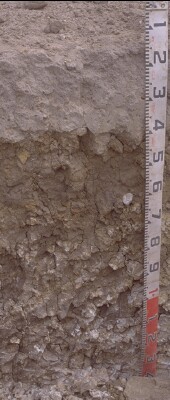SW74
Location: Tulloh
Australian Soil Classification: Bleached-Vertic, Eutrophic, Brown CHROMOSOL
General Landscape Description: Undulating low hills.
Site Description: Waxing upper slope, western aspect.
Geology: Thin Tertiary (Dilwyn or Eastern View Formation) over Cretaceous (Otway Group) unconformity.
 SW74 Landscape |
Soil Profile Morphology:
Surface Soil
| A1 | 0-15 cm | Very dark grayish brown (10YR3/2 moist), dark gray (10YR4/1 dry); loamy sand; apedal; hardsetting; pH 5.4; clear change to: |  SW74 Profile. Note: Surface (A1) horizon has been stripped from the soil profile. |
| A2 | 15-40 cm | Olive brown (2.5Y4/3 moist) with faint mottling, conspicuously bleached (2.5Y6/3 dry); sandy loam; apedal, massive; contains few medium ferruginous nodules; pH 5.6; sharp and wavy change to: | |
| Subsoil | |||
| B21t | 40-70/80 cm | Sandy yellowish brown (10YR5/6) coarse angular blocky peds with dark grayish brown (10YR4/2) thick heavy clay coatings; some peds dominantly clay; vertic features; pH 6.0; gradual and wavy change to: | |
| B22tg | 70/80-140+ cm | White (gray N8/0) clay with gray (10YR5/1) coatings; red mottles in white clay; strongly vertic; pH 5.5. This horizon is probably a palaeosol developed on Otway Group sediments. |
Key Profile Features:
- Conspicuously bleached subsurface (A2) horizon
- Strong texture contrast between surface (A) horizons and subsoil (B21) horizon.
Soil Profile Characteristics:
pH | Salinity Rating | |||
Surface (A1 horizon) | Strongly Acid | Low | Non-Sodic | None |
Subsoil (B21 horizon) | Moderately Acid | Very Low | Non-Sodic | None |
Deeper Subsoil (at 100+ cm) | Strongly Acid | Very Low | Non-Sodic | None |

| The surface soil is strongly acid. The subsoil is moderately acid becoming strongly acidic with depth. | Salinity rating is low in the surface becoming very low in the subsoil. |
| The clay content increases markedly at the A/B boundary. |
Horizon | Sample Depth (cm) | pH (water) | pH (CaCl2) | EC 1:5 | Organic Carbon % | Nitrogen % | Exchangeable Cations | |||
Ca | Mg | K | Na | |||||||
meq/100g | ||||||||||
A1 | 0-15 | 5.4 | 4.7 | 0.14 | 7.6 | 0.65 | 2.6 | 0.97 | 0.37 | 0.27 |
A2 | 25-35 | 5.6 | 4.8 | 0.05 | 0.74 | 0.91 | 0.05 | 0.14 | ||
B21t | 45-65 | 6 | 5.3 | 0.08 | 1.9 | 5.2 | 0.08 | 0.49 | ||
B22tg | 100-120 | 5.5 | 4.4 | 0.08 | 1.4 | 8.2 | 0.11 | 0.8 | ||
Horizon | Sample Depth (cm) | Exchangeable Aluminium mg/kg | Exchangeable Acidity meq/100g | Field Capacity pF2.5 | Wilting Point pF4.2 | Coarse Sand (0.2- 2.0 mm) | Fine Sand (0.02- 0.2 mm) | Silt (0.002- 0.02 mm) | Clay (<0.002 mm) |
A1 | 0-15 | 21 | 13 | 22.2 | 9.5 | 39 | 35 | 11 | 9 |
A2 | 25-35 | 15 | 5.3 | 13.7 | 4.2 | 46 | 28 | 13 | 10 |
B21t | 45-65 | <10 | 7.3 | 28.4 | 18.6 | 37 | 8 | 4 | 48 |
B22tg | 100-120 | 13 |
Management Considerations:
Notes
- Possible unconformity of Palaeocene over Cretaceous.
- Strongly vertic with trench collapse.
- This site stood out from adjacent sections of the trench, because of white subsoil material in trench spoil.
Profile Described By: Richard McEwan (April 1999).


